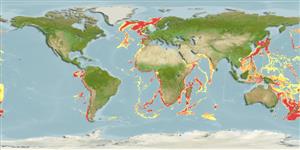Preferred temperature (Fonte Biblio.
123201): 4.1 - 10.6, mean 7 °C (based on 498 cells).
Phylogenetic diversity index (Fonte Biblio.
82804): PD
50 = 0.5001 [Uniqueness, from 0.5 = low to 2.0 = high].
Bayesian length-weight: a=0.00214 (0.00165 - 0.00277), b=3.20 (3.13 - 3.27), in cm total length, based on LWR estimates for this species (Ref.
93245).
Trophic level (Fonte Biblio.
69278): 4.5 ±0.3 se; based on diet studies.
Resilienza (Fonte Biblio.
120179): Basso, tempo minimo di raddoppiamento della popolazione 4.5 - 14 anni (tmax=71; K=0.04-0.05; Fec=5-8).
Prior r = 0.14, 95% CL = 0.09 - 0.21, Based on 1 data-limited stock assessment.
Fishing Vulnerability (Ref.
59153): Very high vulnerability (86 of 100).
🛈
Climate Vulnerability (Ref.
125649): Moderate vulnerability (38 of 100).
🛈
Nutrients (Ref.
124155): Calcium = 4.77 [0.98, 25.62] mg/100g; Iron = 0.271 [0.064, 0.902] mg/100g; Protein = 19.9 [17.6, 22.0] %; Omega3 = 0.294 [0.108, 0.950] g/100g; Selenium = 20.9 [6.4, 61.7] μg/100g; VitaminA = 10.7 [2.2, 53.2] μg/100g; Zinc = 0.248 [0.120, 0.482] mg/100g (wet weight); based on
nutrient studies. 